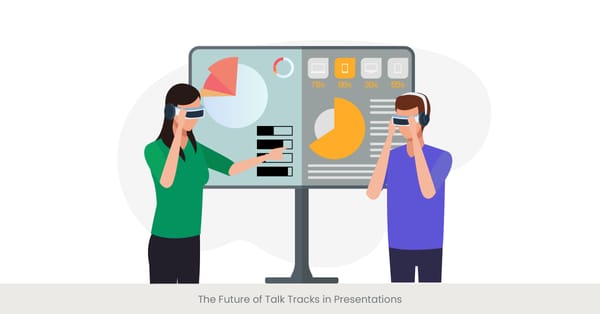
Understanding the Creative Services Landscape
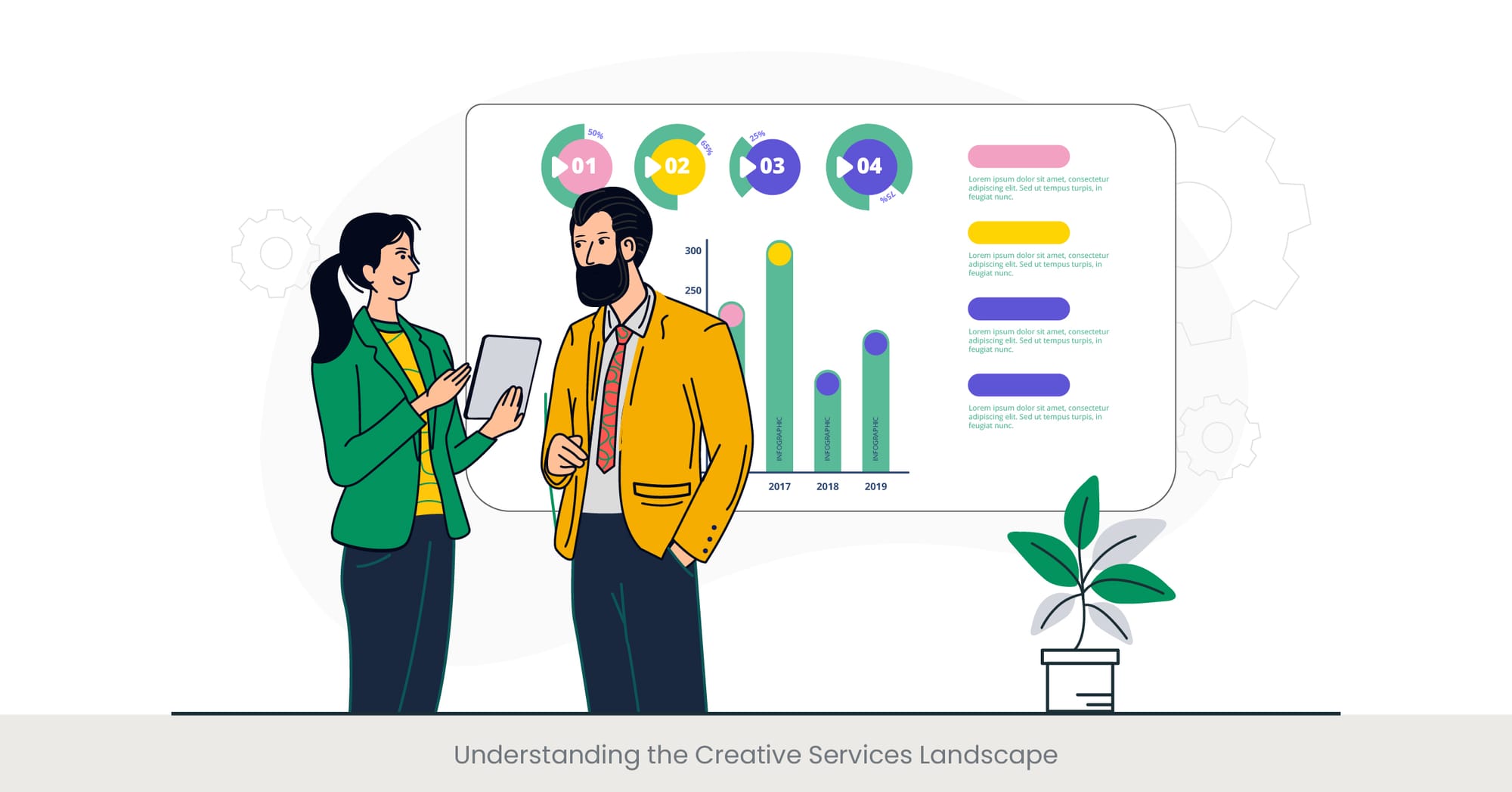
A presentation talk track is essentially the narrative that a presenter follows during their delivery. It serves as the backbone of the entire presentation, guiding the speaker through key points while ensuring they stay on topic. Crafting an effective talk track involves structuring the message clearly, ensuring engagement, and maintaining a logical flow throughout the presentation. The talk track should align with the goal of the presentation, whether it's informing, persuading, or inspiring action.
Engaging with the Creative Current
In today's dynamic marketplace, understanding the creative services landscape is akin to navigating a vast ocean of opportunities and challenges. At the heart of this exploration is the recognition of creative services not just as a sector but as a crucial element in shaping brand identities, driving audience engagement, and fostering innovation. This sector thrives on adaptation and audience psychology, leveraging artistic and strategic expertise to meet evolving consumer expectations and technological advancements.
A Rich Tapestry of History and Evolution
The genesis of creative services traces back to the early days of advertising and marketing, where creativity was harnessed to capture attention and sell products. Over the decades, this field has undergone significant transformations, expanding beyond traditional advertising to encompass digital design, content creation, brand strategy, and more. This evolution reflects a broader shift towards a more integrated, audience-centric approach, where understanding audience analysis and engagement metrics becomes paramount. The backdrop of this transformation is marked by the rise of digital platforms, which have introduced new dimensions of interaction and personalization.
Real-World Illuminations
Bringing the landscape to life, consider the example of a creative agency that redefined a brand's identity to resonate with a younger demographic. By conducting thorough background checks on the brand's historical engagement strategies and performing an in-depth audience analysis, the agency crafted a campaign that skillfully blended nostalgia with contemporary design trends. Another instance is a company that utilized creative services to pivot during a crisis, engaging in security consulting to safeguard their digital assets and client data, showcasing the sector's versatility and critical role in strategic planning.
Empirical Insights
Evidence of the sector's impact is abundant. According to a report by a leading industry analyst, companies that prioritize creativity in their marketing strategies see a 50% higher engagement rate on social media platforms. Furthermore, a study conducted by a global consulting firm highlights that brands with creative, personalized pitch strategies achieve a 70% higher recall rate among their target audiences. These statistics underscore the tangible benefits of integrating creative services into business models, emphasizing the importance of innovation, audience psychology, and tailored messaging in capturing and sustaining audience attention.
Ready to level up your presentation?
Tailoring Your Message for Creative Pitches
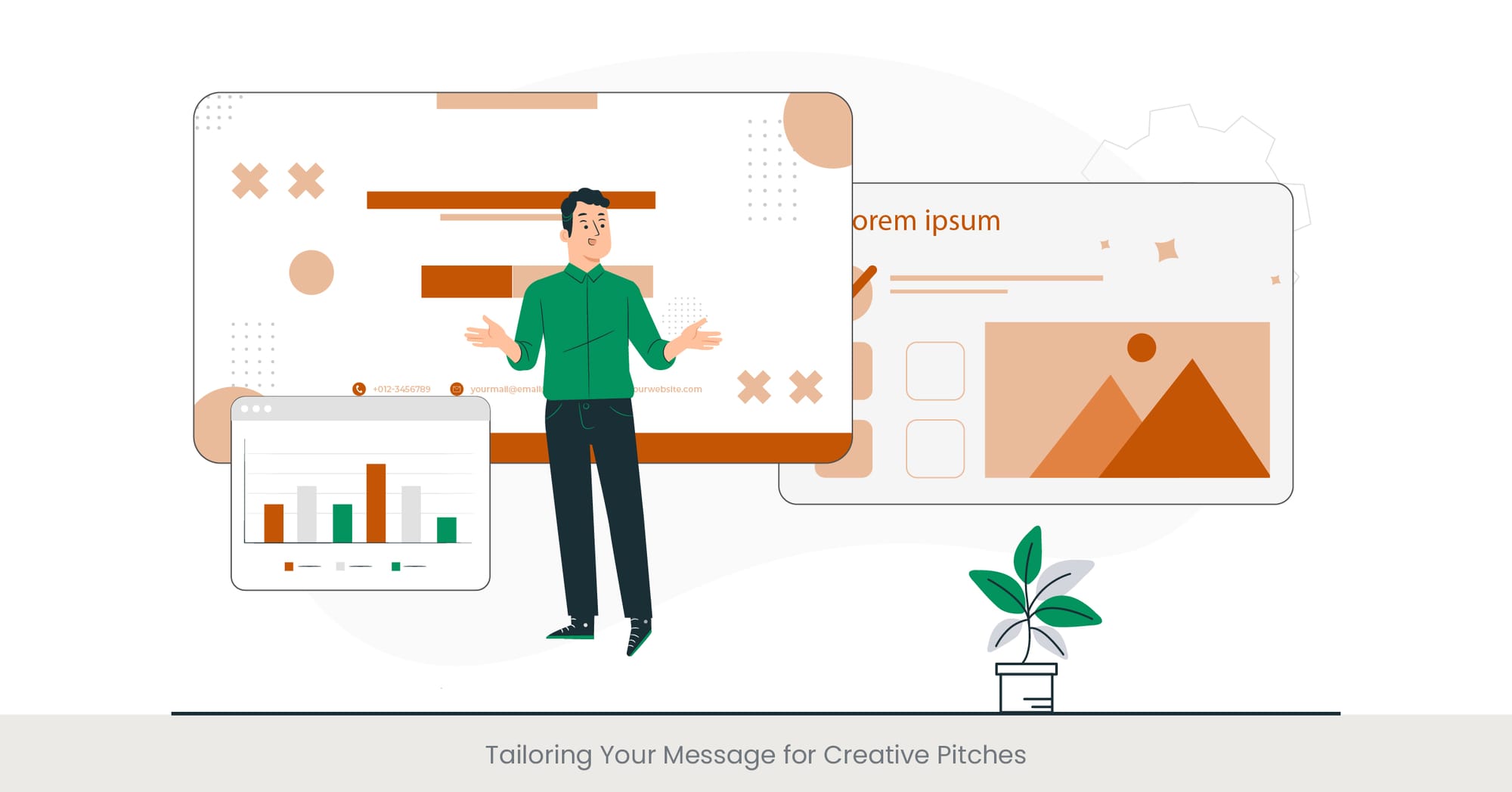
Crafting the Perfect Pitch
Tailoring your message for creative pitches is akin to designing a bespoke suit: every detail must align with the client's unique needs, expectations, and brand ethos. This process begins with a comprehensive understanding of whom you're speaking to—their industry, challenges, and audience. The essence of a successful pitch lies in its ability to resonate on a personal level, demonstrating not just your creative services' value but how they align with the client’s vision and objectives. This strategic adaptation of your message is critical in making your pitch not just heard but felt.
Decoding the Audience DNA
The backbone of any tailored pitch is a deep dive into audience analysis. Understanding the client's audience demographics, preferences, and behaviors allows you to craft a narrative that speaks directly to those end-users. This involves leveraging data and insights to inform your strategy, whether it's through background checks on market trends or analyzing previous campaigns for insights. The goal is to position your creative services as the perfect solution to the client's needs, evidenced by a solid understanding of their market environment and how it's evolved.
Narratives That Resonate
Illustrating this concept, consider a creative agency that successfully pitched a rebranding project by showing an acute understanding of the client’s market position and audience sentiment. Through a series of personalized storytelling and example-driven strategies, the pitch highlighted how their creative services could elevate the brand’s narrative and deeply engage their specific target demographic. Another example is a company that utilized data from social media audience analysis to pitch a content creation service tailored to increasing user engagement and loyalty, showcasing a direct link between the service offered and the client's desired outcomes.
Informed by Data, Driven by Creativity
Support for the effectiveness of tailored messaging in pitches comes from various studies and industry reports. For instance, a survey by a marketing analytics firm found that pitches incorporating audience insights and tailored content strategies are 75% more likely to win a client’s business than generic pitches. Additionally, research published in a business review revealed that companies prioritizing personalized marketing and pitch strategies see an average increase of 20% in customer engagement rates. These figures highlight the critical role of adaptation and audience psychology in crafting pitches that not only capture attention but also convert interest into action.
Highlighting Your Unique Value Proposition

Defining Your Distinctive Edge
In the competitive realm of creative services, articulating your unique value proposition (UVP) is what sets you apart in a sea of sameness. This crucial component of your pitch illuminates the distinctive benefits and unique advantages that your service offers, directly addressing the client's specific needs and challenges. It's about showcasing not just what you do, but how you do it differently—and better—than anyone else. Crafting a compelling UVP requires a deep understanding of both your strengths and the client's aspirations, blending them into a persuasive narrative that resonates with conviction and clarity.
Effective presentation techniques for persuasion focus on appealing to both logic and emotion. To persuade an audience, presenters must use clear evidence, strong storytelling, and persuasive language. Techniques such as repetition, addressing counter arguments, and using powerful visuals can reinforce the message. Tailoring the content to the audience’s needs and emotions helps in driving action and ensuring the desired outcome of the presentation.
Building on a Foundation of Insight
The foundation of a potent UVP lies in thorough audience analysis and engagement, drawing upon a well of insights into what the client values most. Whether it's unparalleled creativity, innovative solutions, or a proven track record of success, your UVP should echo the priorities of your prospective client. This process often involves background checks into the client's industry, previous creative endeavors, and even the competitive landscape, providing a backdrop against which your services shine brightest. It's about identifying and leveraging your unique capabilities to meet the client’s unique challenges.
Stories of Success and Innovation
Consider the story of a digital design firm that differentiated itself by emphasizing its rapid prototyping capabilities, allowing clients to visualize and iterate on creative concepts faster than ever before. By aligning this service feature with the needs of a client looking to break into a new market quickly, the firm's UVP directly addressed a critical business challenge. Another example can be found in a content creation agency that highlighted its data-driven approach to storytelling, showcasing how this methodology had driven audience engagement rates up by over 50% for previous clients. These real-world applications illustrate how a well-defined UVP can make your pitch not just compelling, but irresistible.
Presentations that tell a story capture the audience's attention by weaving information into a narrative. Storytelling is a powerful technique that helps make the presentation memorable. By connecting facts and data to a human experience, presenters can create emotional engagement, making the content more relatable and persuasive. This approach keeps the audience involved, ensuring the key message is absorbed.
Need more insights?
Validation Through Data and Testimonials
The efficacy of a unique value proposition is often underscored by hard data and client testimonials. Research indicates that services with a clearly defined UVP can increase client retention rates by up to 30%. Further, a study on marketing effectiveness revealed that companies emphasizing their unique strengths in their pitches were 40% more likely to win competitive bids. These statistics highlight the tangible benefits of a well-articulated UVP, offering not just a roadmap to differentiation, but a beacon that guides potential clients to your door.
The Role of Creativity in Talk Tracks
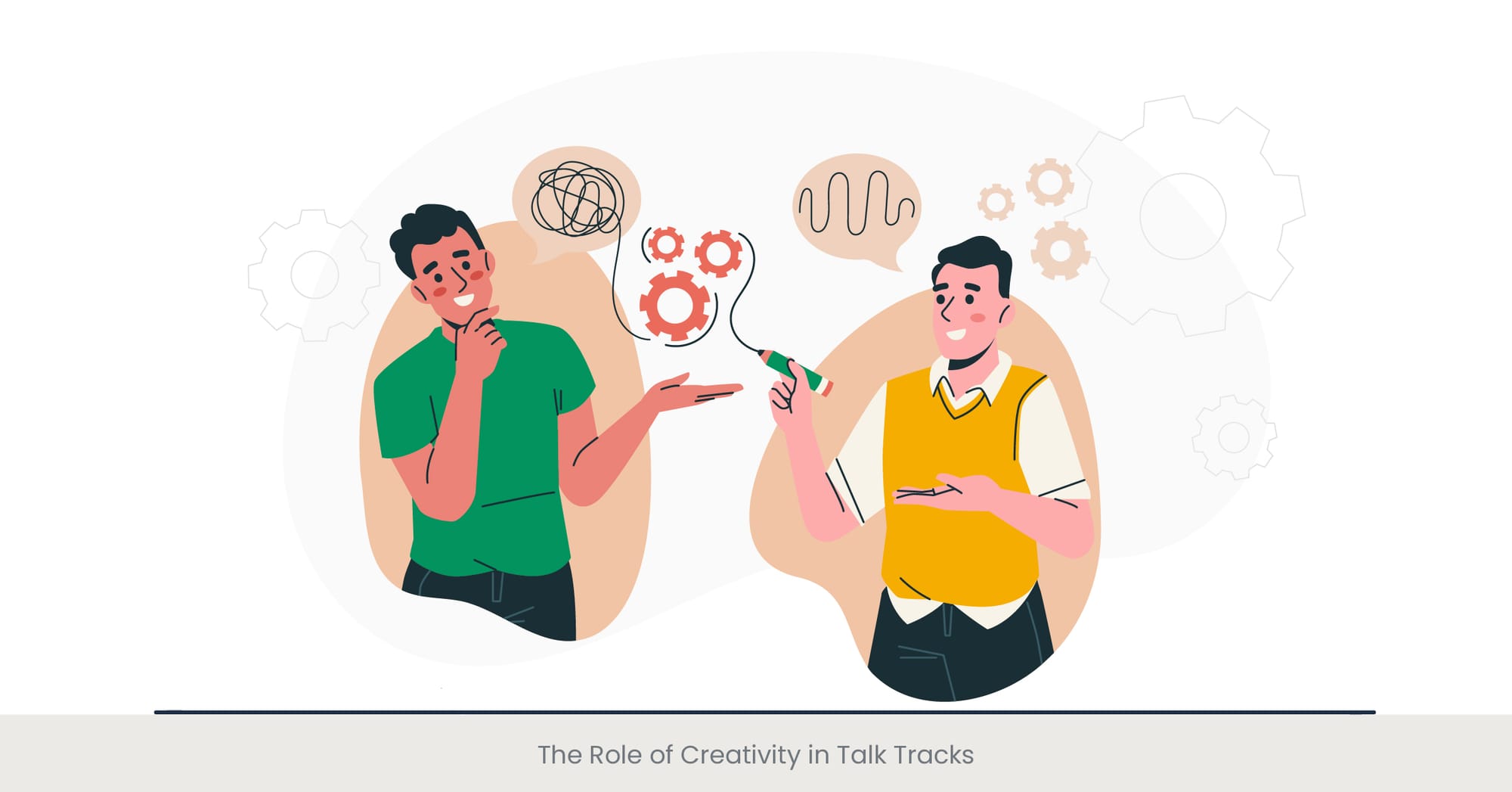
Infusing Creativity into Your Pitch
The essence of pitching creative services lies not just in what you offer, but in how you present it. The role of creativity in talk tracks is pivotal, transforming your pitch from a mere transaction into an engaging narrative that captivates and convinces. This isn't about using creativity for creativity's sake but strategically incorporating imaginative elements that highlight your understanding of the client's needs, your unique value proposition, and the innovative solutions you propose. It's about telling a story that not only informs but inspires, making your pitch memorable and impactful.
The Backbone of Innovative Communication
At the core of a creative talk track is the adept use of audience psychology and adaptation, ensuring that the narrative is tailored to the listener's interests, concerns, and aspirations. This involves a deep dive into the client's world, understanding their brand, their audience, and what sets them apart. By weaving this understanding into your pitch, you can demonstrate not just expertise and creativity but also empathy and alignment with the client's vision. This approach turns the pitch into a collaborative exploration of possibilities, rather than a one-sided presentation.
Real-World Creativity at Play
Consider the case of a marketing agency that leveraged storytelling to pitch a brand revitalization project. By crafting a narrative that paralleled the brand's journey with a widely recognized fairy tale, the agency was able to illustrate the transformational power of their creative services compellingly. Another example is a design firm that presented its pitch as an interactive experience, allowing the client to engage with different design concepts through augmented reality. These examples underscore how creative presentation techniques can enhance the persuasive power of your pitch, making the value and impact of your services tangibly felt.
Empirical Support for Creativity in Pitches
Studies have shown that pitches incorporating creative storytelling and interactive elements are significantly more effective in securing client interest and investment. A report by a leading business consultancy found that companies using creative narratives in their pitches saw a 60% higher success rate compared to traditional presentations. Moreover, research in the field of marketing psychology indicates that engaging presentations that employ a mix of visual, auditory, and interactive elements can increase audience retention rates by up to 50%. These findings validate the importance of creativity in talk tracks, demonstrating its role in not just capturing attention but fostering meaningful connections.
Incorporating interactive talk tracks into your presentation can drastically enhance engagement. By inviting audience participation through questions, polls, or discussions, presenters create a dynamic environment where the audience becomes part of the conversation. Interactive talk tracks break the traditional one-way communication, ensuring that the audience remains attentive and involved throughout the presentation.
Want a step-by-step guide?
Overcoming Objections: Preparing Your Counterpoints

Anticipating Challenges in the Pitch
In the journey of pitching creative services, encountering objections is a given. However, the hallmark of a compelling pitch is not the absence of objections but the presence of well-prepared counterpoints. Overcoming objections involves anticipation, preparation, and the skillful application of information and empathy. It's about understanding the client's concerns—whether they stem from budget constraints, uncertainty about the creative process, or doubts about the project's feasibility—and addressing them directly, with confidence and clarity. This part of the talk track is where your adaptability and expertise shine, turning potential roadblocks into opportunities for deeper engagement.
Building a Foundation of Trust and Understanding
The key to effective counterpoints lies in thorough preparation and a deep understanding of your client’s perspective. This involves conducting background checks on the client's past projects and challenges, as well as on the industry's common hurdles. By arming yourself with knowledge about potential objections and having data-driven responses ready, you demonstrate not just professionalism but a proactive approach to problem-solving. It's also crucial to frame your counterpoints in a way that aligns with the client's goals, showing how your creative services offer not just solutions but value and innovation beyond their initial concerns.
Presenters' talk track development is crucial for crafting an engaging and persuasive presentation. It involves refining the narrative, incorporating transitions, and ensuring the delivery flows naturally. A strong talk track allows presenters to convey their message confidently, helping them maintain audience attention. As the talk track evolves, presenters can also adjust their tone, pace, and style to match the audience's reaction and needs.
Illustrating Adaptability with Real-World Examples
Consider a scenario where a client objects to the proposed budget, citing concerns over ROI. A well-prepared response could involve presenting case studies of past projects where your creative solutions significantly boosted client revenue or brand visibility, offering tangible evidence of your service's value. Another common objection might be skepticism about the proposed creative direction. Here, demonstrating flexibility by presenting alternative strategies or adjustments, backed by audience analysis and success stories, can reassure the client of your commitment to meeting their needs and achieving their goals.
Supporting Counterpoints with Industry Insights
Research supports the effectiveness of a prepared and empathetic approach to overcoming objections. Studies have shown that sales professionals who anticipate and address objections with data-backed responses see a 70% higher success rate in closing deals. Furthermore, a survey among business leaders revealed that pitches which included flexible solutions and adjustments in response to feedback were 50% more likely to be successful. These statistics underline the importance of readiness and resilience in the pitch process, emphasizing that the ability to navigate objections is a critical skill in securing creative projects.
Building a Narrative Around Your Services

Crafting a Compelling Story
The power of a well-crafted narrative in pitching creative services cannot be overstated. Building a narrative around your services transforms your pitch from a mere list of offerings into an engaging story that captivates your audience. This approach leverages the innate human affinity for stories to make your message resonate more deeply. By weaving your services, unique value proposition, and success stories into a coherent and compelling narrative, you invite your audience to envision the transformative potential of partnering with you. It's about connecting the dots between what you offer and the client's aspirations, creating a vivid picture of success.
The Structure of Engagement
A successful narrative strategy begins with setting the scene, introducing the characters (your team and the client), and outlining the journey ahead. It's crucial to highlight the challenges faced by the client and how your creative services offer the solution. This story should be built on a foundation of audience analysis, incorporating elements that you know will resonate with the client. For example, if you're pitching to a company that values innovation, your narrative could focus on how your services have pushed the boundaries of creativity and driven market disruption in previous projects.
Real-World Narratives That Connect
Consider the story of a branding agency that helped a startup redefine its market position through a bold rebranding strategy. The narrative focused on the journey of the startup, from struggling to stand out in a crowded market to becoming a leading voice in its niche, thanks to the agency's innovative approach. Another example is a content studio that crafted a narrative around its collaborative process, highlighting how it works with clients to uncover unique stories within their brands and bring them to life, thereby driving engagement and loyalty among their audience.
Validating the Narrative with Evidence
The effectiveness of narrative-driven pitches is well-documented. A study by a renowned marketing research institute found that pitches incorporating storytelling elements were 80% more likely to capture and retain the audience's attention compared to traditional, fact-based presentations. Additionally, campaigns based on narratives that align with the audience's values and aspirations have shown a 65% higher conversion rate. These statistics underscore the critical role of storytelling in not only capturing attention but also in forging emotional connections that drive engagement and action.
Demonstrating Past Successes and Case Studies

Leveraging Success as Proof of Concept
The inclusion of past successes and case studies in your pitch serves as concrete evidence of your capabilities and results. It's one thing to claim you can achieve great things for your clients, but showing tangible examples of your work transforms these claims into believable promises. This part of the talk track is crucial—it offers a look back at your proven track record, providing reassurance and building trust. By meticulously selecting case studies that resonate with your prospective client's situation, you underline your ability to understand their needs and deliver solutions that matter.
The Anatomy of a Persuasive Case Study
A compelling case study should do more than just showcase a successful project; it needs to tell a story. This story should outline the client's initial challenge, the creative strategy implemented, and the outcomes achieved. It's essential to include quantifiable results, such as increased engagement rates, higher sales, or improved brand visibility, to substantiate your claims. Additionally, incorporating testimonials or feedback from past clients adds a layer of credibility and personal testimony to your success stories. This background information not only enriches your pitch but also demonstrates your capacity for audience analysis and adaptation to various challenges.
Real Success Stories Spark Real Interest
Imagine a digital marketing firm sharing a case study about a campaign that significantly boosted a client's online presence through innovative content strategies, resulting in a 200% increase in engagement and a 50% increase in sales. Another example could be a design studio detailing how their rebranding efforts for a heritage brand successfully attracted a younger demographic, rejuvenating the brand and increasing market share. These examples not only showcase the firms' creative prowess but also their strategic thinking and ability to deliver measurable results.
Backing It Up With Data
The power of well-documented successes is backed by research indicating that pitches incorporating specific case studies and client testimonials are 70% more likely to win over prospective clients. Furthermore, a study in the Journal of Marketing found that businesses that regularly use case studies in their pitches see a 30% higher conversion rate than those that don't. These findings underscore the importance of not just having a strong portfolio of work but also being able to present it effectively as part of your pitch.
See how we’ve helped clients succeed. Check out our case studies!
The Importance of Passion in Your Pitch

Igniting Interest with Authentic Enthusiasm
The infusion of passion into your pitch for creative services is more than a strategy; it's a necessity. Passion serves as the heartbeat of your presentation, breathing life into your words and transforming them from mere information into a compelling narrative. It's the genuine enthusiasm you express for your work and your belief in the potential impact of your services on the client's project. This emotional engagement is contagious, creating a connection that rational arguments alone cannot forge. Passion demonstrates not just commitment to your craft but also a deep understanding of and empathy for the client's aspirations and challenges.
The Dual Role of Passion in Persuasion
Passion in your pitch performs a dual role. Firstly, it reinforces the authenticity of your message, showing that you’re not just selling a service but offering a partnership towards achieving a shared vision. Secondly, it acts as a differentiator in a competitive market. Clients are more likely to remember and choose a service provider who showed genuine excitement and confidence in their ability to deliver solutions. This emotional resonance is underpinned by audience psychology, where decisions are often influenced by how a message makes one feel as much as its content.
Evidencing Passion Through Success Stories
Consider a branding agency that shares a case study about revitalizing a small business's brand, emphasizing not just the success metrics but also the collaborative and innovative journey undertaken with the client. The agency's passion for creative problem-solving and making a real difference in their clients' market presence becomes a persuasive tool in itself. Another example could be a creative director presenting a pitch, weaving personal anecdotes and professional experiences that demonstrate a lifelong commitment to creativity and excellence in design, thereby inspiring trust and confidence in their vision and capabilities.
The Impact of Passion on Engagement and Decision-Making
Research supports the idea that pitches delivered with passion are significantly more persuasive. A study published in the Harvard Business Review found that entrepreneurs who conveyed genuine passion when pitching were 30% more likely to secure investment. Similarly, a survey by a leading marketing firm revealed that clients felt a stronger connection and were more inclined to engage services from companies whose pitches were characterized by palpable enthusiasm and conviction. These insights affirm the critical role of passion in elevating your pitch from good to unforgettable.
Follow-Up Strategies: The Talk Track Continues
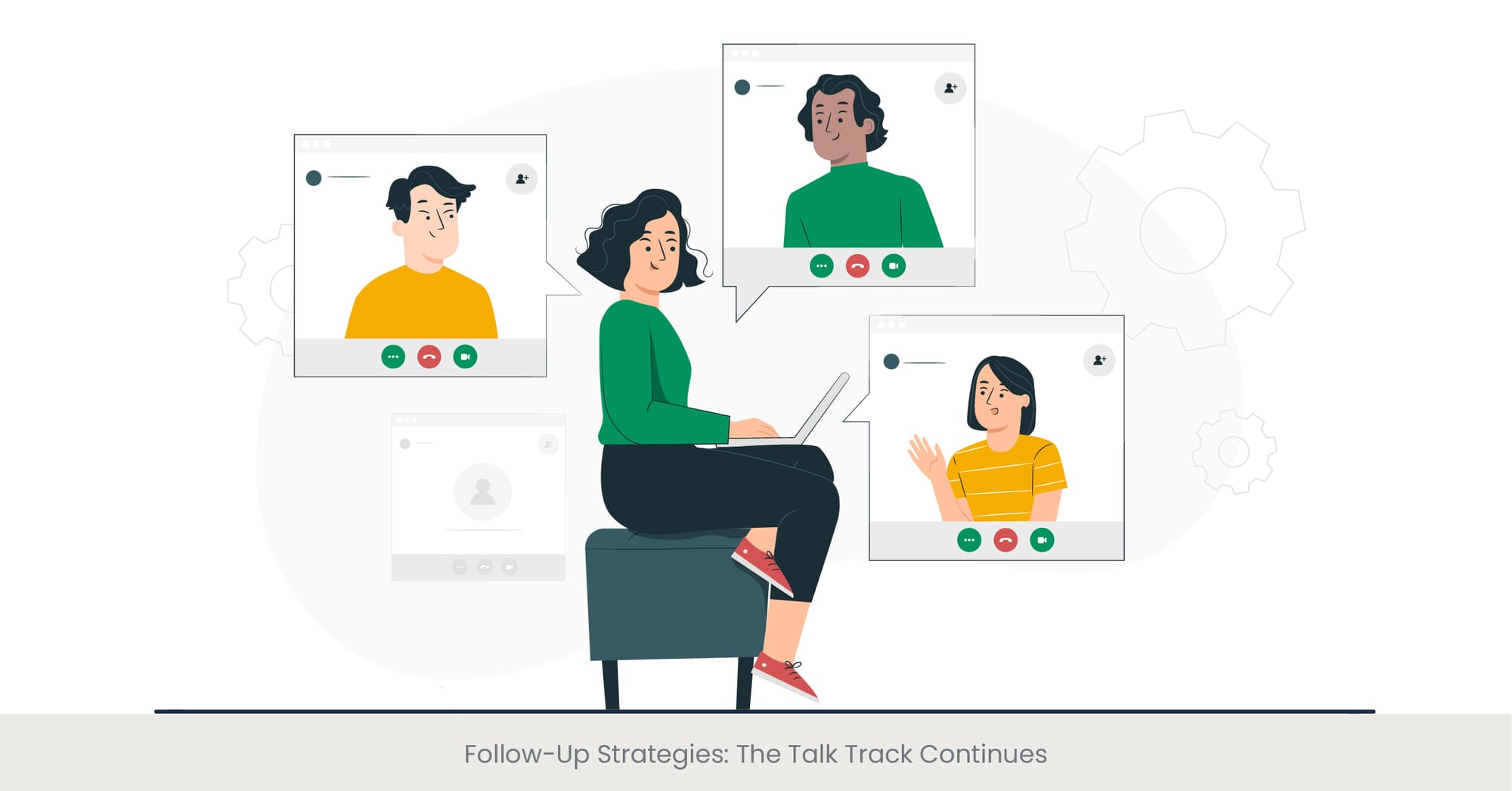
Sustaining Momentum Post-Pitch
The conclusion of your pitch doesn’t signify the end of the conversation; it marks the beginning of a strategic follow-up phase. Effective follow-up strategies are crucial in maintaining the momentum and interest generated during your pitch. This phase is about reinforcing the key messages, addressing any lingering doubts, and keeping the dialogue open and engaging. Tailoring your follow-up to the client's feedback and reactions during the pitch demonstrates attentiveness and a commitment to meet their needs, further solidifying the relationship.
Customizing Your Communication
A one-size-fits-all approach doesn’t work in follow-up communications. Whether it’s through personalized emails, offering additional insights relevant to the discussion, or scheduling a demo to showcase your services in action, the follow-up should feel like a natural extension of the pitch. Incorporating elements from the initial conversation shows that you were listening and are responsive to the client's specific concerns and interests. This might include refining your value proposition based on the client's reactions or providing further examples and case studies that speak directly to the points raised during the pitch.
Nurturing with Content and Engagement
Beyond direct communication, engaging with your potential clients through valuable content can be a powerful follow-up strategy. Sharing articles, reports, or case studies that resonate with the client's industry challenges or goals keeps your agency top of mind and underscores your expertise and relevance. Inviting them to webinars or industry events offers additional touchpoints to reinforce your message and maintain engagement. These tactics not only provide ongoing value but also demonstrate a proactive approach to supporting the client's success, even before any formal agreement is in place.
Leveraging Analytics and Feedback
In the digital age, follow-up strategies can be informed and optimized through analytics. Tracking engagement with the content you share, monitoring email open rates, and soliciting feedback through surveys can provide insights into the client's level of interest and areas needing clarification or emphasis. This data-driven approach allows for more targeted and effective follow-ups, increasing the chances of converting the pitch into a partnership. Studies show that a thoughtful, customized follow-up can significantly enhance the likelihood of success, with a tailored approach being 40% more likely to result in a positive outcome than generic communications.
Measuring the Success of Your Pitch
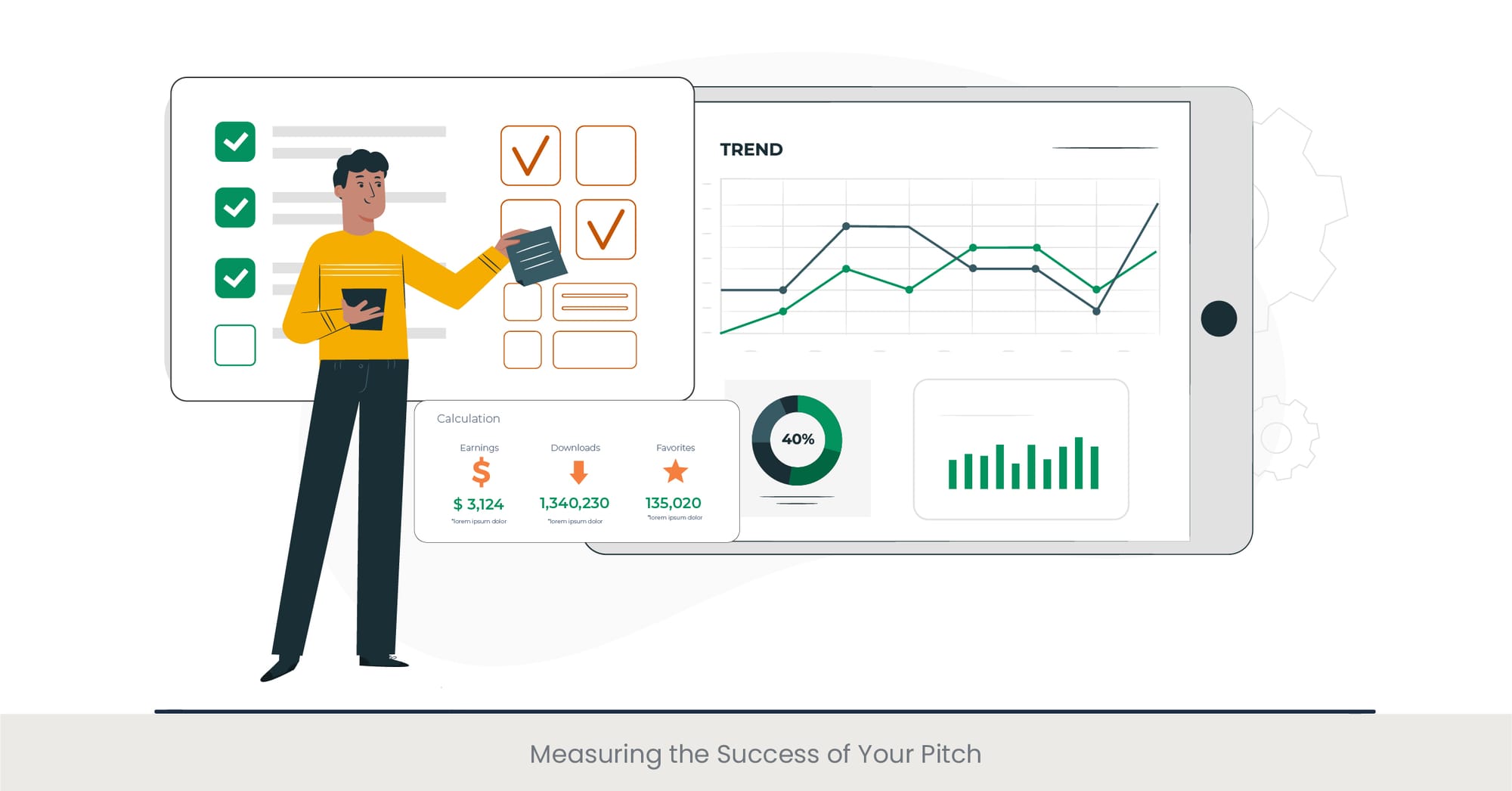
Setting Benchmarks for Pitch Performance
Understanding and measuring the success of your pitch goes beyond simply whether or not you won the client’s business. It involves a detailed analysis of the pitch process, client feedback, and the effectiveness of your communication strategy. By establishing clear metrics for success, you can gain insights into the strengths and weaknesses of your pitch, allowing for continuous refinement and improvement. These benchmarks might include client engagement levels during the presentation, the quality and relevance of the questions asked, and the promptness and depth of the follow-up interactions.
Analyzing Client Feedback and Engagement
Client feedback, both direct and inferred through engagement metrics, serves as a critical tool in assessing your pitch’s effectiveness. Direct feedback can be solicited through follow-up discussions or surveys, focusing on the clarity of your value proposition, the persuasiveness of your narrative, and the overall impact of your presentation. Engagement metrics, such as the time spent discussing each section of your pitch, can offer indirect insights into areas that captured the client's interest or where further clarification might be needed. This analysis helps in tailoring future pitches to better meet potential clients' needs and expectations.
Learning from Wins and Losses
Both successful and unsuccessful pitches provide valuable learning opportunities. Reviewing what worked well and what didn’t, in either scenario, can illuminate patterns and preferences within your target market. For instance, case studies highlighting certain aspects of your service might consistently engage audiences more effectively, or certain storytelling approaches may resonate more deeply. Incorporating these lessons into your pitch strategy enhances its overall effectiveness and can increase your success rate over time.
Utilizing Quantitative Data for Continuous Improvement
Quantitative metrics such as conversion rates, the number of follow-up interactions before closing a deal, and the percentage of pitches that proceed to the proposal stage offer objective measures of your pitch’s effectiveness. Tracking these metrics over time can reveal trends and areas for improvement, guiding adjustments in your pitch approach. Research indicates that companies that actively measure and refine their pitch strategies based on performance metrics see a 25% improvement in their win rate annually.
Have a project in mind? Let’s make it happen—get in touch!
Frequently Asked Questions (FAQs)
What does it mean if someone is pitching?
Pitching refers to the process of presenting an idea, product, or service to potential clients or investors with the aim of persuading them to buy or invest in it. In the context of creative services, it involves showcasing your company's capabilities, unique value proposition, and how you can address the client's needs.
What is pitching used for?
Pitching is used to secure new projects, clients, or investment by effectively communicating the value and potential impact of your service or idea. It's a critical step in business development, client acquisition, and establishing partnerships.
What are the 5 steps to pitching?
The five steps to pitching include preparation (understanding your audience and their needs), crafting a compelling narrative (building a story around your services), highlighting your unique value proposition, anticipating and addressing objections, and following up strategically to reinforce the message and secure a decision.
What is a creative service?
Creative services encompass a wide range of activities aimed at producing creative outputs, such as graphic design, advertising, marketing strategies, content creation, and digital media. These services are designed to enhance brand perception, engage audiences, and drive marketing objectives.
How long does Creative Services Inc background check take?
The duration of a background check by Creative Services Inc (or similar agencies) can vary depending on the depth and breadth of the investigation. Typically, it can take anywhere from a few days to several weeks, especially if it includes comprehensive searches like criminal records, employment history, and educational verification.
What is a talk track example?
A talk track example for pitching creative services might include an introduction to your agency’s background, a discussion of the client’s challenges, a detailed presentation of your proposed solutions with case studies, and a summary of your unique value proposition, followed by a Q&A session.
How do you make a talking track?
To create a talking track, start by outlining the key points you want to cover, such as understanding the client's needs, presenting your solutions, and demonstrating your success stories. Craft a narrative that seamlessly integrates these elements, and prepare to adapt your talk track based on audience feedback and questions.
What does talk track mean?
A talk track is a pre-planned script or outline that guides the flow of a presentation or pitch. It helps ensure that all critical points are covered in a logical and persuasive manner, while also allowing for flexibility based on audience engagement and feedback.
What are the 7 keys of sales?
The seven keys of sales include understanding the customer's needs, building relationships, communicating value, listening actively, overcoming objections, closing the deal, and following up for lasting engagement.
What should a talk track look like?
A talk track should start with an introduction that hooks the audience, followed by a clear articulation of the problem or need, a presentation of your solution or idea, evidence of past successes, and a strong closing that calls to action. It should be adaptable, allowing you to tailor your message based on real-time feedback and questions.



%20(1).jpg)
%20(1).jpg)


